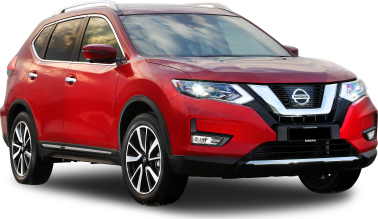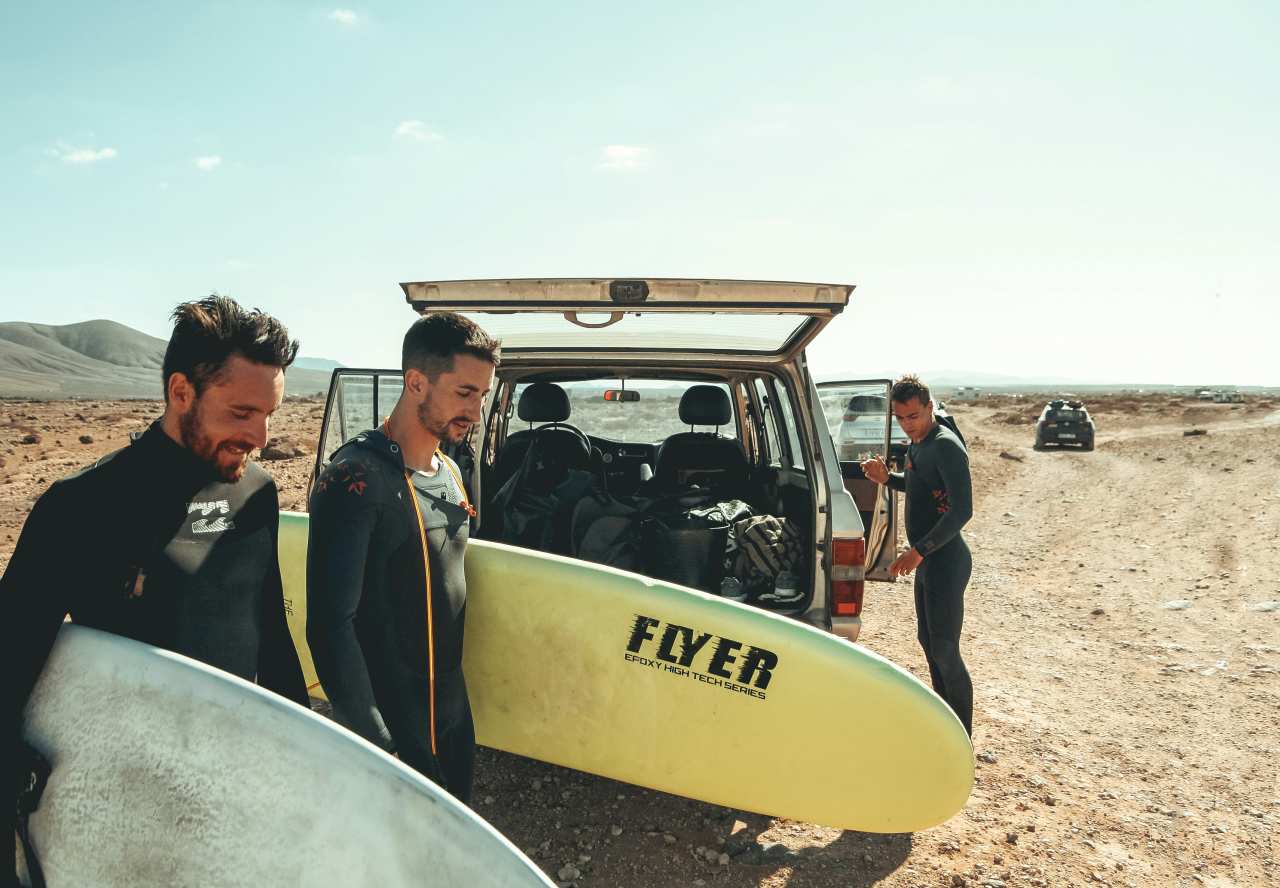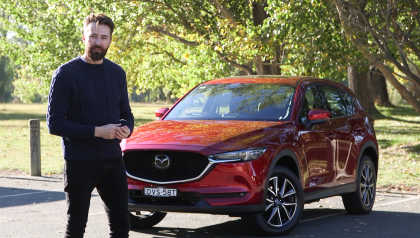Buyer remorse, it's such a downer. You know, you get it home and you're suddenly hit by a wave of sinking clarity that had deserted you when buying, "What the hell was I thinking?" Those jeans, or that couch... in that colour? "OMG... I'm an idiot...!" This new car? Whoa, that's a biggie. That's not one you want to get wrong.
So let's look at this X-Trail TL turbo-diesel $47,790 (plus on-roads). In a compact SUV segment where seemingly not much is different, what is different – if anything – about Nissan's X-Trail? And why would you choose this purchase over another?
In truth, the top-selling five or six can all make a strong play for the contents of your wallet. All, from the funky Kia Sportage to the sober RAV4, are well-featured and represent reasonable value for money, most hold strong retained values (when it's time to trade in), most offer 2WD and AWD as drivetrain options, and most do that SUV cross-over thing pretty capably – of being practical city runabouts and versatile holiday wagons.
Nissan X-Trail 2018: TL (4WD) TAN Trim
| Engine Type | Diesel Turbo 4, 2.0L |
|---|---|
| Fuel Type | Diesel |
| Fuel Efficiency | 6.1L/100km (combined) |
| Seating | 5 |
| Price From | $17,600 - $22,220 |
| Safety Rating |
|
Is there anything interesting about its design?
There is not a lot of room for creativity within the compact SUV styling formula (it's gotta be upright, high-riding and square-backed). That said, the X-Trail's lines are unmistakeably its own.
It looks, in fact, a little more rugged and a bit more "off-roady" than, say, the crisp after-dark elegance of the CX-5 and the modern urban-style of Kia's Sportage. To this reviewer's eyes, the X-Trail's styling sits closer to a conventional 4X4 look.
.jpg)
Its off-road pretensions are strengthened by the heavily-chromed inverted ox-bow grille, sculptured wheel-arches, guards-filling 19-inch wheels and good ground clearance. At 210mm, the X-Trail's underbody clearance is beaten, by mere millimetres, by the Forester's 220mm – allowing both to reach a little further off-road.
In fact, it's not just pretence here: the X-Trail has always offered more in off-road capability and 4x4 smarts than many owners may realise. It's not for dragging up a fire trail, but it can capably account for itself on outback roads, washouts and on firm sand.
And depending what you have in mind for your family SUV, having that extra off-road versatility may just tip the X-Trail your way. Add that it's comfortable, quiet and – in turbo-diesel configuration tested here – no slouch on road, and the case for the X-Trail firms somewhat.
.jpg)
How practical is the space inside?
As in most SUVs, the X-Trail's driving position is upright, providing a commanding view over the bonnet and around the car. The small, flat-bottomed sports steering wheel is a cracker and everything is easily adjusted for that 'just right' driving position.
The second-row seats are reasonably well-shaped and comfortable with lots of legroom on offer (for long-shanked teens). Passengers there get theatre-style seating, set slightly higher than the front. They also get seat-heating, slide and recline (for extra legroom or to create extra cargo space behind), and individual air-vents.
.jpg)
The boot, thanks to that upright squared-off back, is practical and large. Offering 565 litres, it can easily swallow a family-sized load of luggage. Or, if just the two of you, the rear seats can be laid flat, opening up 945 litres of cargo space – you'll fit a couple of pushbikes and weekend clobber there without too much jiggling.
And, incidentally, below the floor is a nifty space for tucking away valuables, or smaller items you wish to protect from crushing or sliding about. It is also helped by having a space-saver spare. You can argue the toss about the merits, or demerits, in that. Me, for everyday use and holiday travel, I'm not troubled by a space-saver at all; anyway, I always carry more than one spare if heading outback.
You will be surprised by how spacious the X-Trail feels inside, and how large it and others in the compact SUV segment have become. It's now family-car size – two adults, three kids – and for space, features and on-road presence, is leaning on the category above, which includes the Kia Sorrento, Hyundai Santa Fe, et al.
.jpg)
Does it represent good value for the price? What features does it come with?
If you're weighing up your budget, Nissan's X-Trail range starts at $28,490 (ST petrol manual, 2WD, plus on road costs), the 4WD versions kicking in at $32,990 (4WD 2.5 litre petrol auto, plus on roads).
This one, the leather trimmed and heavily kitted X-Trail TL 4WD turbo-diesel – sitting at the top of the range – will squeeze no less than $47,790 (plus on-roads) out of the purchase. There's a lot of car here, but, for most of us, that's a price-point not to be sneezed at.
However, there can be few complaints about the quality feel of the X-Trail TL's plush interior and the long list of standard features packed into the deal.
.jpg)
This model feels very much the premium package. Beautifully trimmed and appointed, the double-stitched leather seats – real hide and faux-leather, also power adjustable – are first-class, as is the leather highlighting on the dashboard, doors trims and elsewhere.
Perhaps, at Nissan, there are a few things washing across from its luxury Infiniti brand, but the interior of the X-Trail TL is very smart and very comfortable.
For features, the turbo-diesel TL is full to the brim. Besides the expected – like hands-free Bluetooth and audio streaming, reversing camera, 7.0-inch touchscreen, CD/MP3/USB/Aux-in/digital radio and Bose premium sound – the TL adds cruise control, tilt and slide panoramic sunroof, heated seats front and rear, heated steering wheel, in-built sat nav (with turn-by-turn directions), tyre pressure alert, lane-departure alert and assist, intelligent emergency braking (with pedestrian protection) high-beam assist, around-view monitor and Nissan's advanced drive-assist display in the binnacle ahead of the driver.
.jpg)
The reversing camera and around view monitor make reversing a breeze. There is also cross-traffic alert for when backing out of parking spaces, and 'moving object detection' which provides an alert if objects are detected moving close by the vehicle (providing extra protection for toddlers at home I'd think).
Not quite such a breeze is the motion-activated tailgate. Great feature, if you can get it to work consistently. Me, no chance. Whatever car, whichever brand, I'm inevitably left standing there on one leg like a total Wally; cubit of clobber in the arms, while flapping the other leg around like a stick insect having a seizure in the forlorn hope the car will detect the flapping foot and flip open the tailgate.
Maybe it's to do with dust that accumulates on the sensor under the rear of the car, but, to me, this is an emerging technology – and one yet to work as it should. To be fair, the strike rate with the X-Trail TL's tailgate (working on maybe one-in-three attempts) is no worse than any other.
What are the key stats for the engine and transmission?
There is a fair spread of performance in the X-Trail range. The base model 2.0 litre 2WD ST, with 106kW and 200Nm of torque on hand to move a not-inconsiderable 1425kg, has its work cut out. The 4WD turbo-diesel TL however, while it carries a 200kg weight penalty, at 1664kg, can muscle up 130kW and a hefty 380Nm.
Connecting all those ergs to the road is Nissan's Xtronic Continuously Variable Transmission, or CVT, driving through a part-time 4WD system.
Until recent years, CVTs attracted more negative press than positive comment – "noisy", "droning", "annoying" was the consensus – but the new stepped-ratio CVTs have mostly put an end to that.
.jpg)
The seven-speed CVT in this X-Trail works like a conventional auto, except for the rapid changes between the ratios. This is a really good unit; it 'zinks' between ratios on upshifts, kicks down rapidly when a sudden burst of speed is called for, and changes down pre-emptively (using engine braking) on long declines or when slowing for a corner.
For those who are interested in such things, CVTs are gaining ground with manufacturers because they're lighter and simpler than conventional automatic transmissions, do not suffer the efficiency losses of a torque converter (producing better fuel economy), and, thanks to their simplicity, would seem to last forever.
What's it like as a daily driver?
The turbo-diesel X-Trail TL is no sportscar, but is not found wanting on-road. It is certainly lively enough away from the mark and untroubled by hills even with a load up – carried by that wave of torque underfoot. It is also a safe and responsive highway performer. When called upon to overtake quickly, the X-Trail diesel gets out and around in very brisk fashion.
For family driving, it's got the balance between performance and handling just right.
And, importantly, it goes about things without sounding breathless or 'thrashy'. At highway speeds it is very quiet on-road (even when working hard), and is settled – it doesn't hunt between ratios in the CVT on a long uphill haul, for instance.
Part of that settled nature is due to maximum torque (those 380Nm) kicking in right where it's needed, at 2000rpm – right at highway cruising speed. It's also to do with the operation of the CVT which is free of flaring (over-revving) and feels locked when it steps to the next ratio.
As for adventures off the beaten path, the CVT/transaxle is connected to an intelligent all-wheel drive system that enables you to confidently tackle conditions that would be impossible (or not very sensible) in a conventional car or any 2WD SUV.
There's some real sophistication in this set-up. The key to its all-mode 4x4 system is the electronically controlled coupling ahead of the rear differential, and the selectable-mode rotary switch at the gear selector.
In Auto mode, under normal driving conditions, the X-Trail operates in 2WD through the front wheels (for greater fuel efficiency), only engaging the rear axle when slip is detected at the front. Then, in mere milliseconds, power is directed to the rear wheels, with up to 50:50 distribution between front and rear drive.
It can also be locked into 4WD (via the rotary switch). In Lock, the electronically controlled coupling locks the torque distribution 50:50 front to rear. But, if vehicle speed increases, it defaults to Auto mode, switching back to Lock as speed falls.
In 2WD mode, which can also be selected (such as in normal highway driving or poking around the city) the coupling is unlocked permanently. (However, even when in 2WD mode, the system will automatically direct drive to the rear under heavy acceleration or when turning sharply.)
What's it like for touring?
The steering is weighted nicely for highway driving (we've mentioned the very appealing sports steering wheel) and the ride, assisted by some intelligent braking technology (active ride control and trace control) is among the best in the segment.
It is not as alert at the wheel as Mazda's CX-5, but it is quieter, with less road and mechanical noise intruding.
.jpg)
In practical terms, as a country tourer or a holiday wagon, the X-Trail diesel 4WD is quiet and controlled on tarmac and unusually stable on rutted gravel roads and corrugations (free of the sudden sideways lurch that can catch out a 2WD in these conditions). And, once at your destination, is more than capable of getting off-road, into a favoured beach or around a boggy paddock.
In this, the X-Trail is also helped by Hill Descent Control, again activated by a switch at the centre console. This is a really handy feature if negotiating your way down to a mountain stream, using the transmission and braking control to 'hold' the vehicle to a crawling speed when on a steep descent.
Also helping is the X-Trail's 210mm ground clearance.
.jpg)
In fact, as we alluded to earlier, and have had reason to discover on other occasions, the X-Trail has more than a little off-road capability.
Sure, it doesn't have a low crawling ratio for picking a line over rocks or scrambling through ruts up a steep fire trail, but, like others of the better light-duty SUVs with a 4WD 'lock' mode (sometimes activated by a dash-mounted button), it will go a lot further and a lot deeper into the bush than many of their owners would ever suspect.
How much fuel does it consume?
Being country based, and out of town, we only managed a highway figure for the fuel consumption.
Suffice to say, the X-Trail turbo-diesel in our hands returned a very creditable average of 7.1L/100km. This doesn't match the 6.1L/100km claimed by Nissan (combined cycle), but our tester was a very new car and we don't 'spare the rod' when reviewing, in an attempt to uncover any quirks or flaws in the feel or performance.
There is an Eco-mode switch low on the right of the dash, but which we used only sparingly; it robs a little responsiveness from under the toe. The TL also comes equipped with auto stop/start, which, in country driving, barely gets a look-in.
For a trip from Melbourne to Wilson's Promontory and back – about 2.5 hours each way – plus a little additional running around, we ticked over around 620 kilometres. And our X-Trail diesel returned an average 7.1L/100km of comfortable driving.
Warranty & Safety Rating
What safety equipment is fitted? What safety rating?
Safety is a strong point with the Nissan X-Trail; it scores, naturally, a five-star ANCAP rating.
It offers however, a little more than most. The around view monitor, in combination with moving object detection has the potential to save the lives. Too many toddlers are injured or killed when straying unnoticed near cars in the driveway or in shopping centre car parks. It's no substitute for all drivers being extra vigilant, but is a welcome safety addition.
The X-Trail also has the full suite of airbags (front, side and curtain), reverse camera, blind-spot warning, intelligent emergency braking with pedestrian detection, ABS, ESP, traction control, vehicle dynamic control, intelligent lane intervention (using brake pressure to nudge you back in the lane) and rear cross-traffic alert.
Other features include forward collision warning, adaptive cruise control, high beam assist, adaptive LED headlights and hill descent control.
Which all adds up to a pretty full board, I reckon.
What does it cost to own? What warranty is offered?
Warranty is three years/100,000km (with an option to extend a further three years). Nissan also offers capped-price servicing for each scheduled service up to six years (or 120,000km).
The first service is $353, $384 for the second, $435 for the third and $440 for the fourth. Pricing information up to the 12th service is listed on the Nissan website.
Verdict
Yep, I quite like this new X-Trail TL. I'm not so sure about the $50k (give-or-take) price point, but there is no argument about the quality of the build, the premium feel to the interior, the overall fit and finish and the very long list of standard features.
To be fair here, there is also no change out of $50k for any of key competitors except the Subaru (which doesn't sit at the same premium-grade as the X-Trail TL).
Powered leather seats, electric tilt and slide sunroof, premium sound, surround view monitor (and a host of similar safety features), these things don't come cheap. Add the capability and utility of the intelligent 4WD, smooth turbo-diesel and a quiet and unfussed on-road feel, and you've got a lot of car packed into the X-Trail TL's price.
You'll save around $3000 on the similarly equipped 2.5 petrol Ti, but it's perhaps not quite the complete package of the turbo-diesel.
Buyer remorse? Start by thinking about that price. If that's not too much of a leap, I think you'll be well-satisfied with a Nissan X-Trail TL in the carport.
So, do you reckon this X-Trail is a worthy Adventure vehicle? Let us know in the Comments section below.
Pricing Guides


.jpg)
.jpg)
.jpg)
.jpg)
.jpg)
.jpg)
.jpg)









.png)








.jpg)





